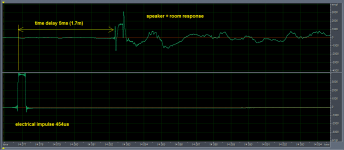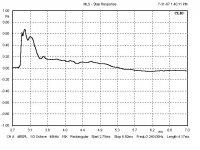As said before, above the bass region fairly large electrostatic speakers have remarkable low harmonic distortion.
Audiostatics (ES600 and ES900) were measured well below 0.1% (over most parts of the audio bandwidth) and i´ve measured -iirc - Quads (29xx) ~0.01% (83 dB Spl/1m/1 kHz).
yes the very low distortion is one of the reasons I own a pair of newer type QUAD's. And they are flat FR on and off axis. BUT, the other limitations, figure of eight dispersion, low sens and low acoustic SPL -- critical room placement, far from walls, lowest freq not reproduced adequately/sufficiently etc all conspired to kill the fun. I keep them only for critical listening due to low distortion and flat freq response. I had them shipped to Bangkok. Now the JBL M2 overcame all my QUAD issues and I still have low distortion and flat FR.
But look at the M2 price or the new QUADS also. If we could improve the common dynamic drivers, it would be a boon to music lovers everywhere at popular prices.
THx-RNMarsh
Last edited:
PMA, I hope you realize that I was being polite. '-) What I see is a 3 way speaker with the tweeter leading, with a midrange out of phase, lagging by about 0.5ms, then the woofer coming in sometime. I cannot make a direct comparison, because the usual measurement is a step response that has more low frequency information, so far as I can tell.
Is it the fact that you used a pulse rather than a step and how relatively 'clean' it graphs?
Is it the fact that you used a pulse rather than a step and how relatively 'clean' it graphs?
Attachments
<snip>
But look at the M2 price or the new QUADS also. If we could improve the common dynamic drivers, it would be a boon to music lovers everywhere at popular prices.
THx-RNMarsh
Of course, price point is a severe drawback of bigger electrostats and other high quality systems as well (holds true even for "not so high quality systems" too though).
But beside the low distortion big panel speakers do have a certain reproduction quality (or signature) that reminds -at least me or some kinds of listeners - more to real sound events than other speakes; sound distribution will be one of the reasons, phase coherence might be another, but as you´ve said mainly only as long as small signal level is ensured and that is considerably lower than in horn loudspeakers of comparable size.
Might be that distortion reduction combined with the Linkwitz open baffle approach (as long as room considerations fit) is - at least - an approximation to the big panel appeal.
Here is a link that is easier to read https://www.bksv.com/en/about/waves/WavesArticles/2018/Measurement-microphones-explained
And not to forget the Brüel & Kjaer Microphone handbook:
https://www.bksv.com/media/doc/be1447.pdf
Electrostats are very specific. Not speaking about directivity, they are limited in SPL and that is the real problem.
I never found Beveridge 2 lacking in level when called for... so it's possible.
//
<snip>
Is there any consensus on IM testing of a microphone being useful for predicting HD? Further should those IM sources be HF or lower frequency? I was thinking of using 250Hz and 350 Hz from two separate speakers however I need some validation since this stuff takes a lot of time. <snip>
Should be so. This kind of difference tone distortion measurement should give a measured number for the single second order term (f2 - f1) that is 6dB higher than the level for the HD2 term if only f2 or f1 is applied; if i´m not completely mistaken 🙂
Assumed that level of f2 and f1 is the same and the frequency difference as small as previously discussed.
PMA, I agree with you that STRICTLY all pass phase shift is difficult, if not impossible to hear directly, BUT step differences created by driver alignment, and many other aspects of phase shift ARE audible by serious listeners.
This was first shown by Manfred Schroeder in 'The Proceedings of the IEEE' in an article in 1975, 'Models of Hearing' as I recall. Please read up.
This was first shown by Manfred Schroeder in 'The Proceedings of the IEEE' in an article in 1975, 'Models of Hearing' as I recall. Please read up.
Last edited:
Electrostatic transducers are limited by the gap. At high frequencies they van be quite efficient and have high output. A 100 Hz high pass filter in front of Quads can get significantly more out before clamping.
Ongoing Discussion
"until you remain in linear excursion area"
I don't think that's what you meant to write.
"until you remain in linear excursion area"
I don't think that's what you meant to write.
well there's a first post into the lions Den. We could all work out what Pavel was saying. As we are an international group we tend to allow for the odd slip for those for whom English is not the first (or even second) language.
😀 Welcome Dave, joined today and straight into this thread with your first post, fairplay 😎 😉
"until you remain in linear excursion area"
I don't think that's what you meant to write.
Amplitude Modulation Method for Measuring Linear Excursion of Loudspeakers on JSTOR
An example of a very crude crossover design, it seems. When polarity doesn't matter then the drivers are about 90 degrees apart, and +90 or -90 gives the same result, except for total phase. The polarity with the smaller total phase is the more correct one (more compact impulse response).What's so strange is that there is almost no difference in measured frequency response when I invert the tweeter in the B652-AIR speakers I got. Just a change in absolute phase.
The hump at 3.5k seems to be my microphone. 3rd image is the difference
Actually, a two-way like this should have a Linkwitz-Riley crossover that has the drivers in phase everywhere (not only at the XO). This gives a deep and narrow notch when one driver is inverted. Also, the main lobe is normal to the baffle, not tilted as it is now.
Last edited:
An example of a very crude crossover design, it seems. When polarity doesn't matter then the drivers are about 90 degrees apart, and +90 or -90 gives the same result, except for total phase. The polarity with the smaller total phase is the more correct one (more compact impulse response).
Actually, a two-way like this should have a Linkwitz-Riley crossover that has the drivers in phase everywhere (not only at the XO). This gives a deep and narrow notch when one driver is inverted. Also, the main lobe is normal to the baffle, not tilted as it is now.
I severly doubt the woofer on those can accurately play much past 800hz.
That box should probably be stuffed tightly, but instead it is lightly.
Even as long as I've worked with computers, I seriously feel like a fish out of water here. I've looked at diyaudio several times over the past several years, and decided to sign up so that I could post and see the various JPGs. "The Lounge" has always been interesting, so, here I am. Sorry if I stepped on any toes, but that comment was clearly wrong, and I don't think he meant it that way.
Anyway, hi.
See what I'm sayin'? I don't even know where this will be posted, or in what order.
Anyway, hi.
See what I'm sayin'? I don't even know where this will be posted, or in what order.
True, this compounds the issue but the dominant thing still is the lack of phase matching around the XO frequency.
Materials science has exploded the last few years. Why hasn't anyone done anything with spiders and surrounds yet?
It’s more of a geometry problem than materials unless you can make it self aware of frequencies and corresponding excursion with frequencies.
The problem with spiders and why they haven't been improved is much more complex as I understand.
The spider needs to be linear in the working region and yet keep the cone from smashing itself against the motor during overload, which is very common.
Furthermore the Q of the speaker can't be allowed to increase beyond xmax because that creates another method of self-destruction.
Common membrane spiders are a type of flexure (the mechanical kind, not the medical kind) with specific properties. Rms increases as excursion increases, to compensate for the loss of electrical braking as the coil moves out of the gap and the increase of Fs. It does this nonlinearly, thus you have hysteresis.
If you design the motor to compensate for the suspension nonlinearity, you end up with the problem that the suspension and motor never totally match or are partly out of phase. So you may reduce the broad error but the higher order errors remain.
Before the cloth spider was used, we had pretty plain multi-point flexure suspensions, page 21:
http://tesi.cab.unipd.it/42449/1/Tesi_Lorenzo_Bortot_-_1014762.pdf
The kind of spider shown more closely resembles an actual spider, so I can imagine what the first generation of spiders looked like.
I would hazard a guess that this kind of suspension can actually be more linear. It just behaves like a spring. The problem is the loss in Rms and possibly it's inability to keep the cone from going to far (let alone the spider itself resonating). Some other method is needed for damping, and speaker protection needs careful consideration.
The spider needs to be linear in the working region and yet keep the cone from smashing itself against the motor during overload, which is very common.
Furthermore the Q of the speaker can't be allowed to increase beyond xmax because that creates another method of self-destruction.
Common membrane spiders are a type of flexure (the mechanical kind, not the medical kind) with specific properties. Rms increases as excursion increases, to compensate for the loss of electrical braking as the coil moves out of the gap and the increase of Fs. It does this nonlinearly, thus you have hysteresis.
If you design the motor to compensate for the suspension nonlinearity, you end up with the problem that the suspension and motor never totally match or are partly out of phase. So you may reduce the broad error but the higher order errors remain.
Before the cloth spider was used, we had pretty plain multi-point flexure suspensions, page 21:
http://tesi.cab.unipd.it/42449/1/Tesi_Lorenzo_Bortot_-_1014762.pdf
The kind of spider shown more closely resembles an actual spider, so I can imagine what the first generation of spiders looked like.
I would hazard a guess that this kind of suspension can actually be more linear. It just behaves like a spring. The problem is the loss in Rms and possibly it's inability to keep the cone from going to far (let alone the spider itself resonating). Some other method is needed for damping, and speaker protection needs careful consideration.
- Status
- Not open for further replies.
- Home
- Member Areas
- The Lounge
- John Curl's Blowtorch preamplifier part III


